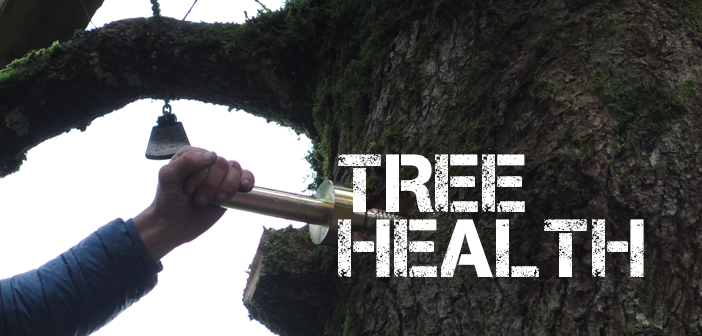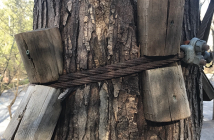While it is possible to attach structures to trees without damaging them severely, it is not possible to eliminate all impacts that result. The best we can do is to understand how the trees will be affected, and use science and knowledge of the local area to limit the impacts, so that both the tree and our structures can enjoy a long, healthy life.
In the Winter 2016 issue of Adventure Park Insider I introduced the concept of “adaptive growth,” a characteristic of all trees. To refresh memories: tree growth is influenced by stresses, natural and manmade, made on the trunk and branches. Trees will strengthen themselves at a point of stress, growing thicker to handle increased weight, or growing over a wound.
Understanding tree growth and how your structure might affect it is critical to the long-term success of your project and the tree. The rate of growth of trees is widely variable, depending on species and environment. Trees are capable of slowing their growth down when resources are scarce, and increasing growth when resources are plentiful. Arborists are well aware that in urban yards, for example, adding irrigation can substantially increase a tree’s growth increment.
To understand how your trees will respond to attachments, it’s essential to determine the rate of growth on your site. Generally, there will be stumps present that reveal the growth rate—so long as the tree is of the type where annual growth rings are visible. For planning purposes, measuring the growth in increments per radius inch is a good rule of thumb.
If you are building in trees that do not reveal their growth as annual rings, it will be more difficult to get an accurate measurement of growth, so consult a local expert for assistance. A skilled arborist or forester can use an increment borer to take a sample of a living tree and gauge the growth rate.
Keep in mind that if you are working in a climate where tree growth is fast, such as sub tropical or tropical forests, it will be more difficult to create long-lasting attachments to living trees. If, on the other hand, you are in an area where tree growth is slow, such as high elevation areas or northern latitudes, you will have more time before tree growth conflicts occur.
Attachment Options
When we decide to attach anything to a tree, there are only a few choices available.
- You can build in some tree species by laying your foundation parts across the tree’s branches, using natural forks. I have often seen this method used with bolts as well.
- You can wrap rope or cable around the tree’s trunk or branches and use that to hold your structural parts in place.
- You can put a threaded rod, lag screw, bolt or tree attachment bolt (TAB) into the tree and fix your structural part to the tree.
- You can suspend a structural part using a bolt or a cable/rope wrapped around a tree limb.
- You can put a bolt or a TAB into the tree and perch your structural part on top of it.
- Compression fittings that allow enough force to avoid slipping are a new experimental technology method, and are also used in a low-tech form.
- You can use a post, or posts, instead of a living tree.
A few considerations for these options:
- If you simply place or rest something with any weight on a tree part, problems for the tree will likely occur sooner or later, depending on species and ecosystem.
- Covering the bark of a tree is always risky, as the conditions at the bark will change. Moisture is trapped, and no light will reach the bark, preventing photosynthesis—which is a characteristic feature of the bark of many trees.
If bolts are inserted into tree parts, the tree will be injured, and the CODIT (compartmentalization of decay in trees) response is triggered (see “Toughing It Out,” Winter 2016). If the structural part is held tight, the tree will begin to envelop it. Know, too, that tree branches generally subside over time under the influence of gravity and other loads like rain and snow, which may cause your structure to sag over time.
If you wrap something around a tree that exerts force against the tree part, the cable or rope will be enveloped over time. The amount of time that process takes depends on the species and the growth rate.
Arborists have studied this phenomenon for a long time. We know that trees can respond in several ways. For one, the material used to wrap the tree will be enveloped, and the tree, again with many variables such as species in play, will be strangled as the vascular transport system is interrupted. In some situations, the tree will cover the constricting material and close over it, in essence repairing the tree’s transport system. When this happens, the tree will have an internal defect at this level forever.
Further, if the tree cannot overwhelm the constriction quickly, then transport up and down the tree through the vascular system will be interrupted. Since the products of photosynthesis cannot reach the main storage area—the root system—sometimes the tree trunk will grow above the constriction.
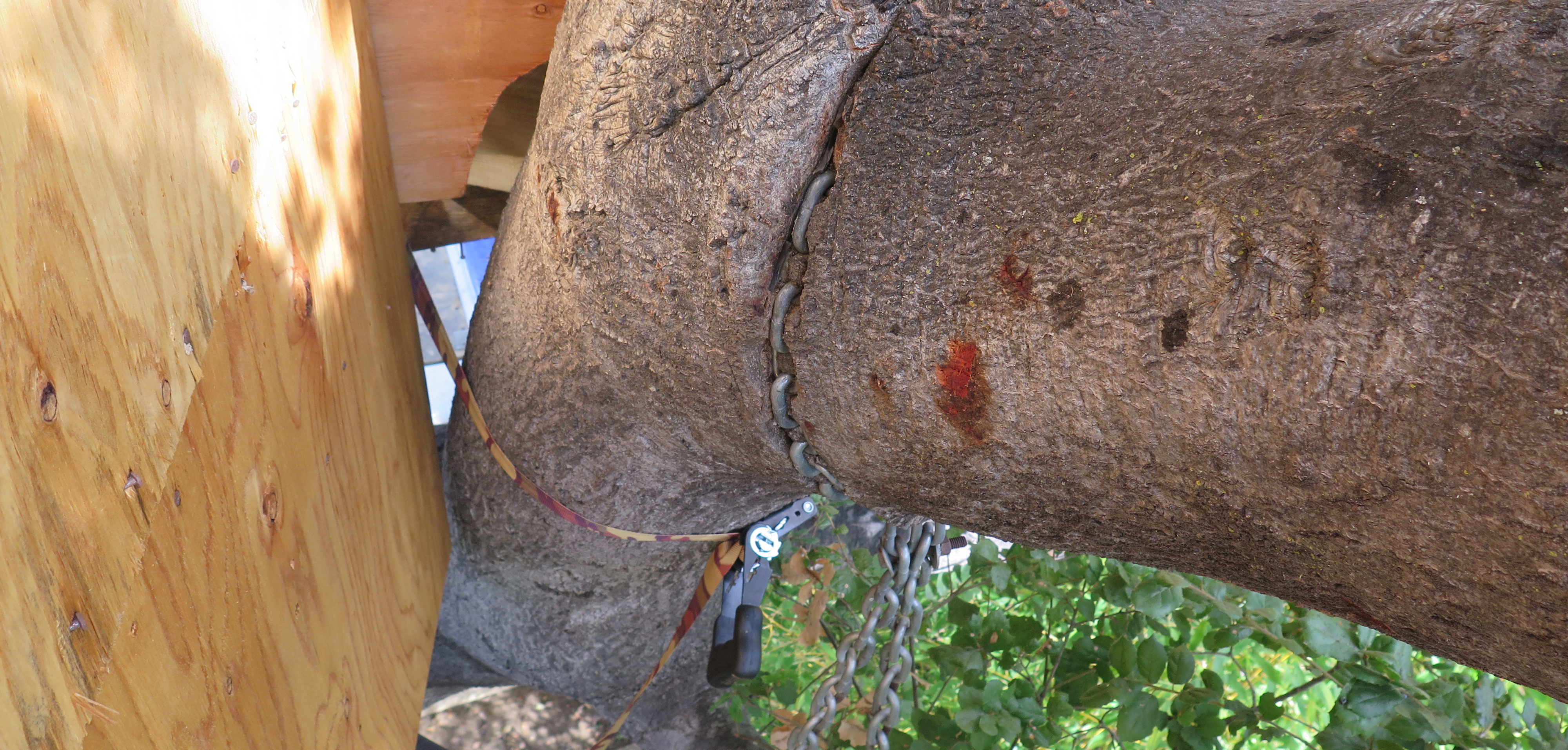
When wrapping trees, many builders put blocks between the cable/rope and the tree part. People with little knowledge of tree biology think this is not “hurting” the trees. My experience and understanding says that this is generally not true. As I’ve said before, any pressure the tree cannot counter will result in envelopment. Also, remember that the tree’s bark under the block may be damaged or killed.
It is also a common practice to bolt the blocks to the tree to avoid movement/slippage of the cable. This triggers the CODIT response and encourages the tree to envelop the blocks. You cannot simply loosen the bolt every year to allow the tree to expand; new tissue will be growing against the bolt, and when you move it, you will injure the tree again! I’d imagine an engineer might find this approach troublesome as well.
If you use a bolt, an all thread rod, or a TAB to attach your structures, you are injuring the tree—although, as we have said, trees are rather good at dealing with holes. How good depends on the species and local environment. Arborists have studied the effects for more than 100 years, so there’s a good knowledge base to work from.
Accommodating Growth
The growth of the tree has to be accounted for, and this can be dealt with using various penetrating attachment methods.
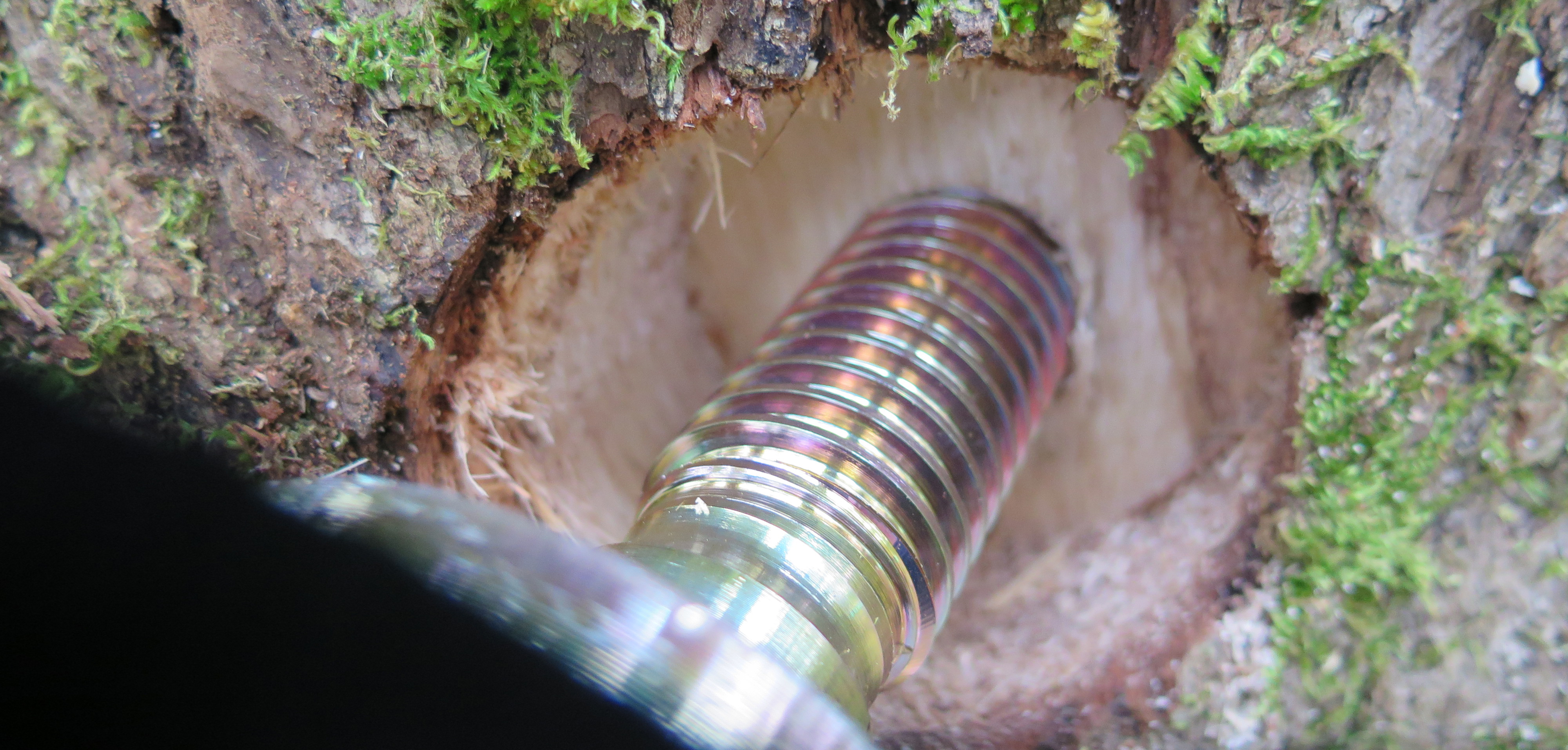
A cadmium-plated TAB being installed in a Quercus garryana at the home of tree-climbing instructor Tim Kovar. The project was profiled on “The Treehouse Guys” TV show.
In the Winter 2016 issue, we noted several facts pertinent to making a hole in the tree’s cambium for a bolt. At the time the hole is drilled, a percentage of the tree’s circumference will be interrupted. Every year the tree continues to grow, this percentage will be reduced. (But as we noted, if there are too many holes in the tree, it is likely that the tree will be weakened physiologically.) Unlike a tree branch, there will be no expansion of the bolt every year, only the trunk will expand, and new tissue will grow along the bolt.

Greenwood’s “Jesus drill” is a rig designed to set TABs.
There are now TABs available that can be extended to accommodate tree growth. Along with technological advances in TAB technology, such as Greenwood Engineering’s XL system.
People have also been experimenting with the use of fittings that use compression to hold the element on the tree. This is an interesting idea, and there will be a lot to learn from these innovations.
I have seen a few such approaches. The first system is the compression ring devised by Ken Huck. This uses four pins with blunt tips that are tightened against the tree bark. These will not be moved, and what we have observed fits with what we expected: the point where the threaded rod presses on the trunk kills the cambium beneath it. The tree then begins to envelop the rod. In the installations I am familiar with, the tree growth rates are slow, and there should be several decades of growth possible before a conflict occurs.
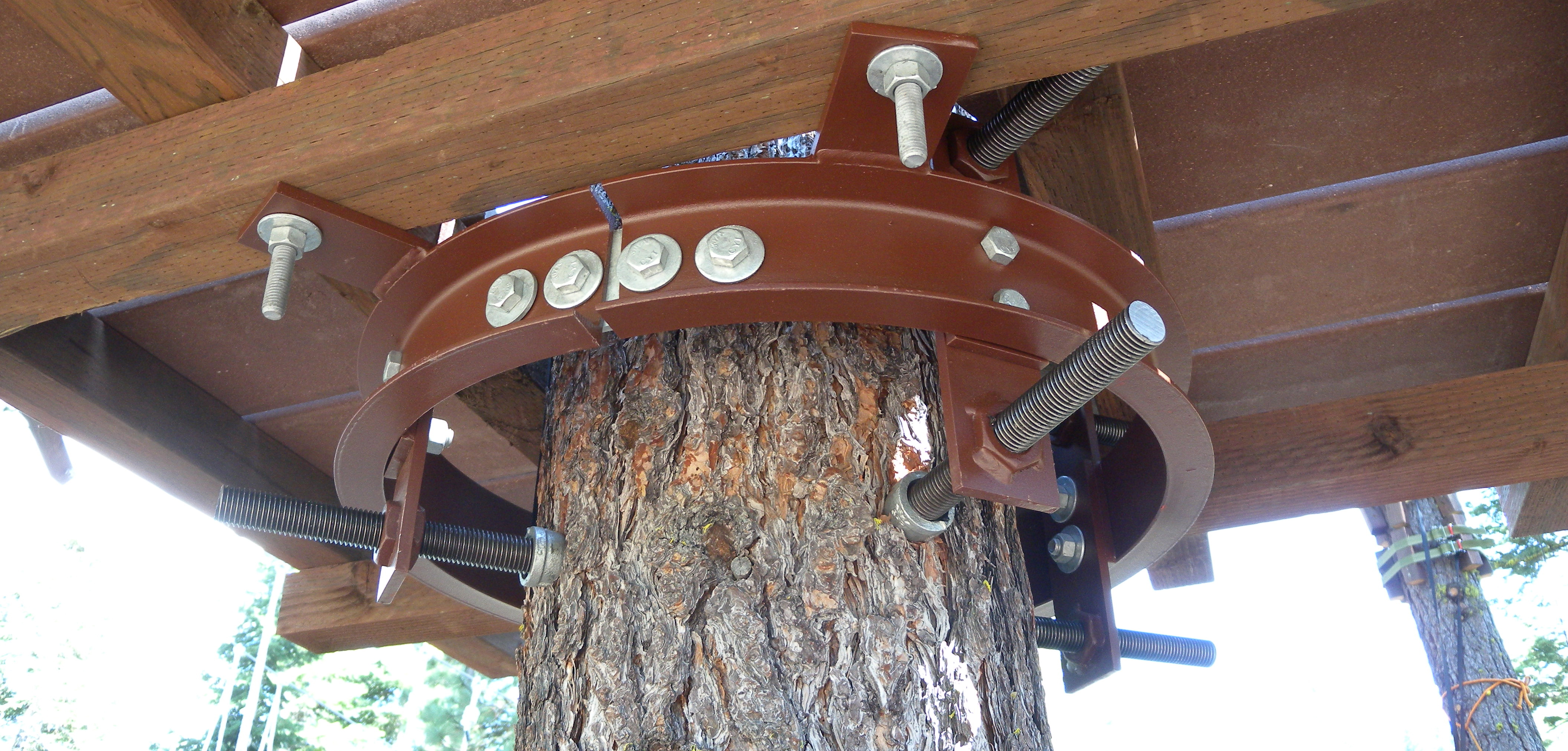
This is Ken Huck’s compression rig, installed at Granilbakkan Tahoe in Tahoe City, Calif., one of North Tahoe Adventures’ sites.
The second system is in use in Australia on a course near Melbourne, called Otway Fly Treetop Adventures. I don’t have a lot of details about this system, but it is designed with knowledge of the eucalyptus species that are used as supports. I believe the fitting is intended to be adjusted to accommodate growth over time. I have also heard second-hand that a builder in the U.S. is experimenting with a compression system that has eight points to contact the tree, four of which are in use and four that will be used to move the pressure points on the tree on a regular basis.
As mentioned earlier, one way to keep impacts to trees to a minimum is to use posts to install your course. This is still a common method, of course. With a good arborist consulting, and using modern methods such as pneumatic excavation with an Air Knife™ or Air Spade™, posts can be set very close to trees. They can also be disguised to look like a tree trunk. Using arboricultural knowledge allows posts in close proximity to trees, without the need for attachments to them. In many locations, a combination of trees and posts could be a potential solution for course designers.
In the future, we’ll go into more detail about different attachment approaches and their physiological and biological outcome for trees. In the meantime, I urge to send me your photos, questions, and stories of your experiences building tree-supported structures so that we can work together and expand our understanding. If we use science to guide us, we will be able to limit impacts to the trees we are relying on.
This article is part of a series on tree health. Read the other articles here:
Part I: Tree Biology and Biomechanics
Part II: Toughing It Out
You can contact Scott D. Baker at [email protected].


